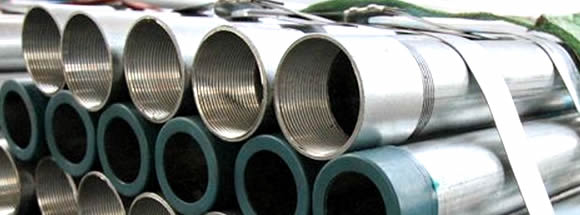

Galvanized Steel are those steel that has been covered with a layer of zinc metal.
Galvanized steel can be made into a strong plumbing or tubing material -- one that resists corrosion from exposure to water or the elements. It has been used used for water-supply pipes or as a strong tubing for outdoor applications.
It is most commonly used for outdoor construction like fences and handrails, or for some interior plumbing. It is also sometimes called galvanized iron pipe. Galvanized steel pipe has been coated with a layer of zinc. The zinc provides a barrier against corrosion so that the pipe may be exposed to the outdoor environmental elements. The protective barrier proves equally effective against damage from indoor humidity.
Galvanized steel pipe is covered with a zinc material to make the steel pipe more resistant to corrosion.
The process of galvanization was first discussed by scientists in the 1770s, nearly 60 years before it was finally introduced in the 1830s. French engineer Stanislaus Tranquille Modeste Sorel took out the first patent for the process in 1937, and began manufacturing it soon after. By the 1850s, Europe was producing galvanized steel out of manufacturing plants located around the continent. The United States followed shortly thereafter, opening its first plant in the 1870s.
To create galvanized steel pipe, steel materials are placed into a molten bath of zinc. This process is also called hot dip galvanization. The two metals are chemically bound to one another in this process, and will therefore never separate, resulting in a more resistant and longer lasting version of steel.
Galvanized Steel Pipe is used in a variety of settings. Until about 30 years ago, galvanized steel was utilized for water supply pipes in construction. It is used in outdoor applications wherever the strength of steel is desired, such as fence posts and rails, scaffolding and as protective railings.
Galvanized steel clamp connection technology applications
When used as water pipe, the zinc barrier coating tends to react to the minerals in the water, often causing plaque to build up inside of the pipe. This impedes the water flow and, in severe cases, may lead to burst pipes. Galvanized piping is connected with threaded fittings that may also introduce leaks into the plumbing if not properly fitted.
There are a number of methods of applying zinc coatings and each will determine the coating’s thickness and its ultimate durability in a specific environments The most commonly encountered types of zinc coatings are:
Zinc electroplating
Mechanical plating
Continuously galvanized sheet
Continuously galvanized wire
Galvanized pipe and tube
General or hot dip galvanizing

Hot dip galvanizing steel pipe with threaded end
Hot-dip galvanizing (HDG), as referenced is the process of dipping fabricated steel into a kettle or vat of molten zinc. While the steel is in the kettle, the iron metallurgically reacts with the molten zinc to form a tightly-bonded alloy coating that provides superior corrosion protection to the steel.
Hot-dip galvanizing is a form of galvanization. It is the process of coating iron, steel or aluminum with a thin zinc layer, by passing the metal through a molten bath of zinc at a temperature of around 860 °F (460 °C).









Tel:
E-mai:
Skype: